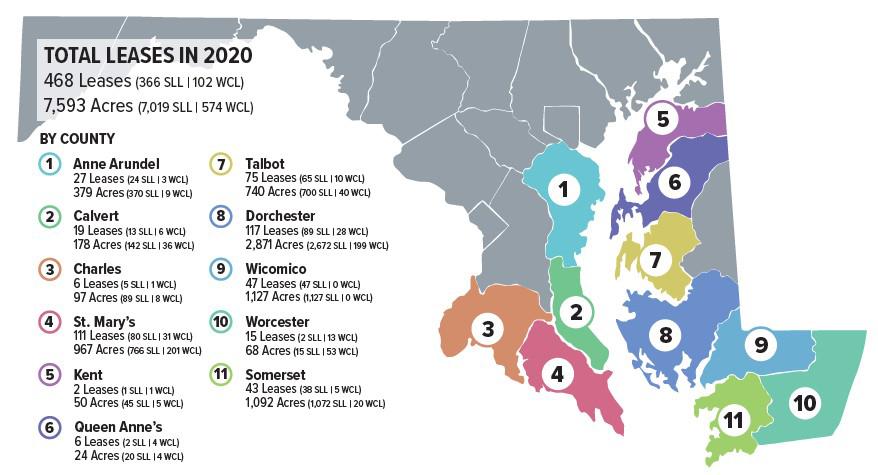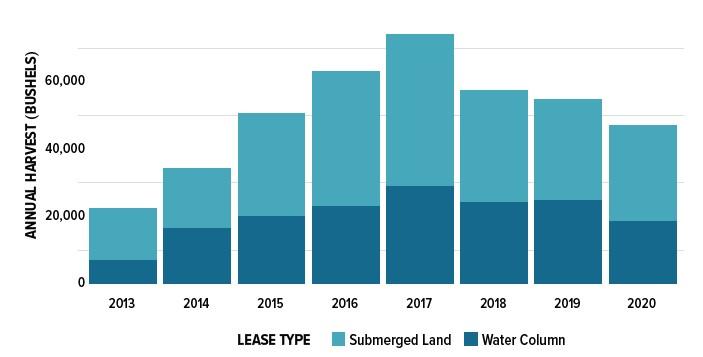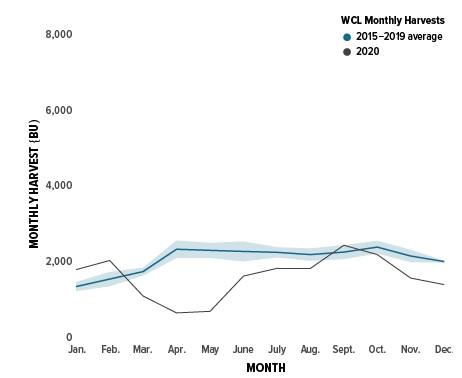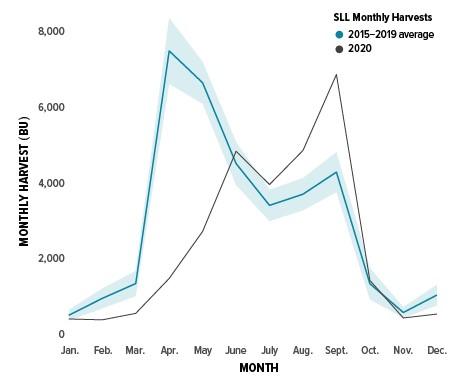
EBR-62 | November 2022
UNIVERSITY OF MARYLAND EXTENSION AND MARYLAND SEA GRANT COLLEGE
Maryland Oyster Aquaculture Industry in 2020 at a Glance
While shellfish have been farmed in Maryland since 1830, highly restrictive laws hampered industry development for decades. In 2009, the state revised its shellfish lease laws and in 2011 streamlined their administration by consolidating multiple state agencies into a “one-stop shop” within the Maryland Department of Natural Resources (MDNR) Aquaculture and Industry Enhancement (AIE) unit. To assist shellfish growers, the MDNR AIE also coordinates the required federal permit from the Baltimore District of the US Army Corps of Engineers, which must be renewed every five years.
Maryland Shellfish Aquaculture (MSA) leases are valid for 20 years, after which they can be renewed for an additional 20 years. In 2010, the Maryland Agricultural Resource-Based Industry Development Corporation launched the Shellfish Aquaculture Financing Fund, resulting in nearly $5.3 million in shellfish aquaculture financing loans to date.¹ Since 2010, the MSA industry has grown by over 400%,² contributing $9.7 million and $8.1 million in economic impact to Maryland in 2017 and 2018, respectively.³
Two Production Methods
Maryland Shellfish Aquaculture uses two production methods: submerged land and water column. On submerged land leases, spaton-shell oysters are grown and harvested directly from suitable bottom (Figure 1A). On water column leases, individual seed oysters are grown in cages or floats suspended in the water column (Figure 1B). Farmers generally harvest oysters from submerged land leases from March to October to avoid competition from the wild oyster harvest season, while oysters from water column leases are generally harvested year-round.

Leasing in Maryland
As of December 2020, there were 468 shellfish leases using 7,593 acres of Maryland waters. Submerged land leases accounted for 7,019 acres with 366 leases, while water column leases totaled 574 acres with 102 leases (Figure 2).

Maryland Shellfish Aquaculture leases were located in 11 counties in 2020 (Figure 3).² Many leaseholders hold multiple leases. Leases range in size from under an acre to hundreds of acres, and water-column leases are generally smaller than submerged land leases. The average size of a water-column lease in Maryland is five acres and the average submerged-land lease is 20 acres.

Factors Affecting Annual Oyster Harvests from Maryland Aquaculture Operations
Oyster larvae availability in previous years, changing environmental conditions, and market competition from shellfish produced in other areas may impact Maryland’s aquaculture harvest in any given year. In 2020, 47,081 bushels of oysters were harvested from Maryland leases, with 28,277 bushels from submerged land leases and 18,804 bushels from water column leases (Figure 4). Note that one Maryland (MD) bushel equals 2,800.5 cubic inches, or 1.3 times a standard US bushel of 2,150.4 cubic inches. The 2020 harvest is 14% lower than in 2019 and 22% lower than the previous five-year average (2015–2019) annual harvest (Figure 4).⁴

An estimated 80% or more of US oyster production is sold through restaurants.⁵ COVID-19 pandemic-related restaurant closures beginning in March 2020 contributed to reduced demand for mollusks, including oysters, in 2020⁶ (Figures 5 and 6).


- MARBIDCO FY 2020 Annual Report: 2020. Maryland Agricultural and Resource-Based Industry Development Corporation.
- Maryland Department of Natural Resources. 2020. Aquaculture Coordinating Council Shellfish Aquaculture Update. December 10, 2020.
- Senten, J.; Engle, C.; Parker, M.; Webster, D. 2019. Analysis of the Economic Benefits of the Maryland Shellfish Aquaculture Industry. Virginia Tech and Engle-Stone Aquatics. Dec 31, 2019.
- Maryland Department of Natural Resources. 2021. All harvest data are provided courtesy of MDNR staff.
- Gulf of Maine Research Institute. 2016. Maine Farmed Shellfish Market Analysis. The Hale Group, LTD. October 2016.
- Senten, J.; Smith, M.; Engle, C. 2020. Impacts of COVID-19 on US aquaculture, aquaponics and allied businesses. Journal of the World Aquaculture Society, 51(3): 574–577.
For more information about shellfish aquaculture in Maryland, including resources for current and prospective growers, please visit extension.umd.edu/aquaculture
SHANNON HOOD*
University of Maryland Center for Environmental Science Horn Point Laboratory, Maryland Sea Grant College
JIM LACHANCE
Maryland Sea Grant College
CATHY LIU
University of Maryland Extension
FREDRIKA MOSER
Maryland Sea Grant College
MATTHEW PARKER
University of Maryland Extension
DONALD WEBSTER
University of Maryland Extension
*Corresponding author: Shannon Hood shood@umces.edu | 410-221-8225
The authors would like to thank the Maryland Department of Natural Resources for providing data on the oyster aquaculture fishery in Maryland. Additionally, the authors would like to thank University of Maryland’s Extension Publications Team and peer reviewers for providing content edits and Maryland Sea Grant communications team for providing copy editing and graphic design for this publication.
Maryland Aquaculture Industry in 2020 at a Glance (EBR-62) is one in a series of publications of the University of Maryland Extension and the Department of Agriculture. The information presented has met UME peer review standards, including internal and external technical review. For help accessing this or any UME publication contact: itaccessibility@umd.edu.
For more information on this and other topics, visit the University of Maryland Extension website at extension.umd.edu.
University programs, activities, and facilities are available to all without regard to race, color, sex, gender identity or expression, sexual orientation, marital status, age, national origin, political affiliation, physical or mental disability, religion, protected veteran status, genetic information, personal appearance, or any other legally protected class.